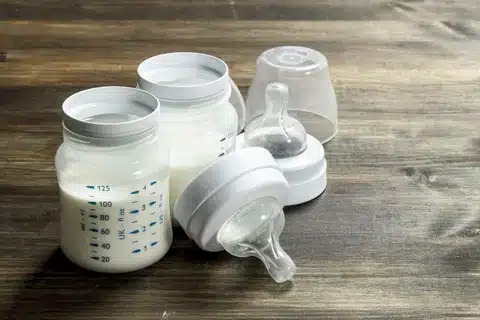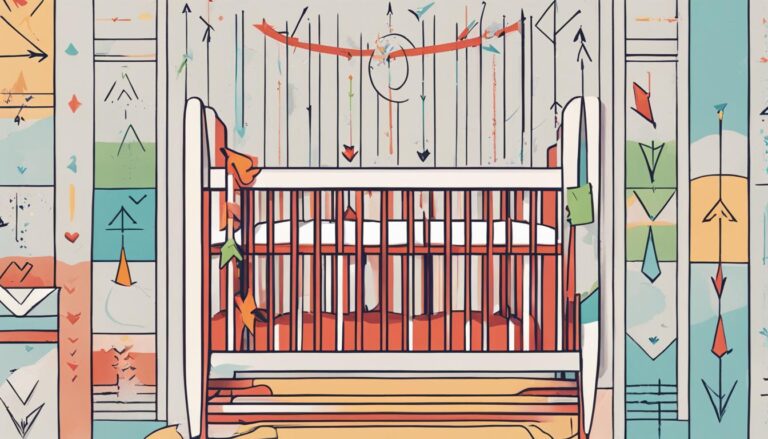Why Can’t You Store Breast Milk In Bottles With Nipples?
Pumping breast milk is one thing, but storing it is another. A lot needs to be considered when storing breast milk to ensure this liquid gold is safe for your little one. The storage equipment, temperature, storage location, etc.
There are also many controversies explaining why storing breast milk in bottles with nipples is undesirable. So, why can’t you store breast milk in bottles with nipples? What happens when you do so? Let’s dig deeper.
Guidelines On How To Store Breast Milk
Before we discuss why you shouldn’t store breast milk in teat bottles, it’s crucial we learn the appropriate breast milk storage conditions. Doing so will help you know how long to store your breast milk to retain its freshness and peak quality.
If you had a healthy full-term infant, you can store the breast milk:
- At room temperature (no warmer than 25 degrees Celsius or 77 degrees Fahrenheit) for four hours.
- At 32-39 degrees Fahrenheit or 0-3.9 degrees Celsius for four days in the fridge.
- In the freezer compartment found inside the fridge for two weeks.
- At 0 degrees Fahrenheit or -18 degrees Celcius in a self-contained freezer connected on the side or top of the refrigerator for six months. Ensure you keep the milk in the back of the freezer, not at the door.
- In a deep freezer with a constant temperature of -4 or -20 degrees Fahrenheit and Celcius for one year.
Remember to leave about an inch of space at the storage container’s top to allow room for expansion of the milk when it freezes.
Note that different sources have different recommendations on milk storage duration. So, if you have any questions or concerns, talk to your doctor.
Why Can’t You Store Breast Milk In Bottles With Nipples?
Although it appears convenient and easy to store breast milk in bottles with nipples, that’s not recommended. The general rule is that you can’t store breast milk in bottles with nipples without extra lids. Here’s why that is so:
- Bottles with nipples alone without an extra lid provide a conducive environment for contamination factors. Since the teats or nipples are exposed to the atmosphere, micro-organisms or dust may attach to the nipple. Once your baby sucks on the nipple, the microbes may enter their blood system, leading to illnesses.
- Sometimes the bottle nipple has an opening to allow for easier milk flow. Storing breast milk in bottles with teats that have openings and don’t have an extra lid makes it easy for germs and bacteria to get in the milk. This results in the bacteria contaminating the milk, making it unsafe for human consumption. And if your child drinks contaminated milk, they may get sick.
Note that this does not apply to bottles left on the counter alone, and include even those stored in your fridge. The refrigerator is not sterile, and leaving a bottle with milk open can also contaminate it.
- Breast milk should always be stored in sealed containers. Storing breast milk in unsealed containers like bottles with teats without an extra lid negatively affects the milk’s quality. The milk may not appear as fresh as stored in a sealed package. Thus, it’s not safe to feed your little one breast milk stored in bottles without a sealed lid.
How Can You Safely Store Breast Milk In Bottles With Nipples?
Sometimes you may be too attached to bottles with nipples that you find letting them go hard. Or you’re not ready to invest in other bottles while you already have. If that’s the case, there are a few ways of safely storing breast milk using bottles with teats:
- You can cover the nipple of the bottle with a cap. Most bottles with nipples come with a nipple lid and a cap lid that covers the nipple. If you plan to use the teat bottle regularly to store breast milk, add the cap on the nipple’s lid top. Ensure the cap seals the bottle well to prevent any air from getting in.
If your nipple bottle didn’t come with a cap, you can buy extra caps online or at regular retailers. Such caps usually have a standard size. It’s also crucial to use bottles made of high-quality materials like glass or BPA-free plastic. Also, ensure the bottles you use for your baby are not used for anything else.
- You may also choose to replace the nipple with a lid. Sometimes luck may not be on your side, and you fail to get a cap that fits appropriately to the bottle. If that’s the case, use a different lid. However, that means replacing the nipple with the new lid. So, once you are done transferring breast milk to your nipple bottle, cover it with the airtight lid instead of the nipple lid and store your milk accordingly. Regardless of your storage condition, don’t let the milk stay for more than the recommended time frame.
Other Breast Milk Storage Options
Besides bottles, there are other various milk storage options. They include:
Storage Bags
Storage bags are inexpensive and a great way of storing breast milk. When purchasing storage bags, ensure you buy the ones specifically designed for storing breast milk and not any other household plastic bag that may burst or be unsterilized. Freeze flat the milk storage bags to save space and stack them in the freezer for three to six months.
Freezing Milk Cubes
This option involves freezing an ounce or half an ounce of breast milk into cubes using freezing milk cube trays. Once frozen, the milk is shaped into bars that can fit through any bottle’s opening. The tray used for freezing milk into cubes can also come in handy when your kiddo starts solid foods and you want to freeze homemade baby food in them.
Conclusion
There are many ways of ensuring breast milk remains as fresh as possible once expressed. Proper hygiene, appropriate storage containers, and optimum storage conditions. Like not storing breast milk in bottles with nipples without extra caps. Doing so exposes the milk to micro-organisms that may contaminate it, making it unsafe for your baby.






